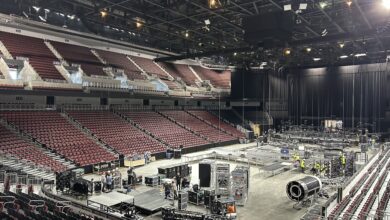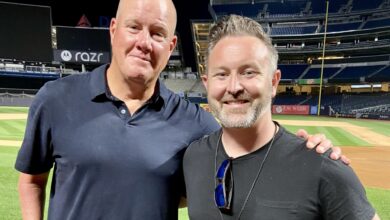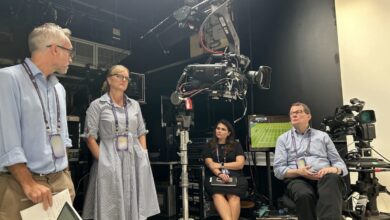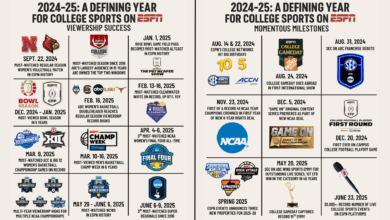This month, fans will indulge in an unprecedented sports smorgasbord, a result of revamped scheduling in the pandemic era.
It’s a good thing ESPN exists to deliver it all, around the clock.
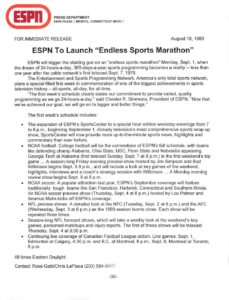
But it was only 40 years ago today – Sept. 1, 1980 – that ESPN anticipated its first birthday with the advent of true, 24-hours-a-day, 7-days-a-week programming.
The start of an “endless sports marathon” with “no more timeouts” was news that then-ESPN President Chester R. Simmons wanted publicized any way possible, as ESPN Senior Vice President, Corporate Communications, Chris LaPlaca, wrote in a Sept. 2011 Front Row post.
ESPN heralded the move with a dramatic announcement (see video above featuring SportsCenter anchors George Grande and Sal Marciano and play-by-play announcer, the late Jim Simpson) and a comedic promo from The Famous Chicken (see sidebar below).
ESPN debuted Sept. 7, 1979, a full eight months before fellow media pioneer Cable News Network (CNN) launched in Atlanta on June 1, 1980. But CNN offered programming around the clock months before ESPN.
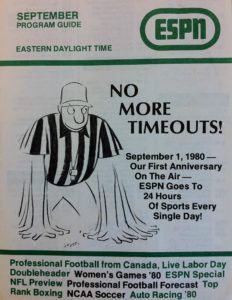
There were days when ESPN programmed around the clock, but many days it did not.
What did ESPN offer in the wee hours between SportsCenter ending the “broadcast day” at 2 a.m. and the 6 a.m. replay of that show?
Did ESPN “sign off” with the playing of the national anthem and the posting of a test pattern, as was the approach of most conventional television stations of that era?
The definitive answer won’t be found in ESPN’s vast video archives. Back then, the fledgling operation often reused videotapes in order to save money. Thus, some wonderful content has been lost.
“I don’t recall seeing ESPN sign off the air,” ESPN Founder Bill Rasmussen says. “We followed programming with a ‘sign-off,’ but it was a scrolling ‘Program Guide’ that ran until conventional programming began again at 6:00 a.m. Eastern.”
SportsCenter anchor Grande does recall playing the national anthem as a signoff.
“When we went to 24/7, we filled with taped SportsCenters, running the 2 a.m. SportsCenter all morning long,” Grande said.
Said Rasmussen: “1980 was more like having just another birthday. During that first year ESPN had done so much: NCAA basketball, College World Series, Frozen Four. It was good press – behind the scenes there was frequent frustration, but turning off the program guide and never signing off again was indeed a big deal, just nowhere near as big a deal as the launch in ’79.”
The Famous Chicken Boosted ESPN's Cause In 1980
In the summer of 1980, ESPN had about 250 employees. The celebrity endorsement budget was nonexistent.
But ESPN scored a coup (or in this case, coop?) when The Famous Chicken – commonly known as the San Diego Chicken – shot a promotion heralding ESPN’s first birthday and its move to 24/7 programming (see video above).
“The piece was shot during my performance at a minor league baseball game for Holyoke (Mass.) Millers,” Ted Giannoulas, who portrays The Chicken, recalls. “I believe [ESPN] reporter Greg Wyatt flagged me down behind the grandstand and I improvised it on the spot in a single take surrounded by many fans.”
Giannoulas, now 67 and living in semi-retirement, was happy to help ESPN hatch its idea.
“When ESPN came onto the scene, it was as exciting a programming moment a cable subscriber could have. Sports news, back in the day, on the local channels, it was five minutes, that’s it. The idea that suddenly you could have hours and hours of sports programming was very exciting,” he said.
The San Diego Chicken’s performing career has spanned 47 years. What began as a $2-an-hour gig promoting a San Diego radio station in a chicken suit bloomed into becoming a major drawing card at San Diego Padres, Chargers and Clippers games in the 1970’s and ’80’s.
Eventually, The Chicken’s gigs went global and his likeness was everywhere. He even co-starred with tennis legend Pete Sampras and various SportsCenter anchors in a “This Is SportsCenter” spot.
– Sheldon Spencer
